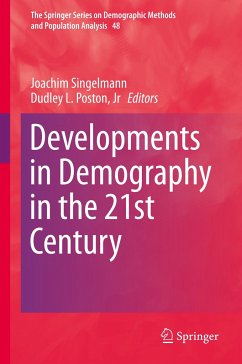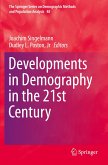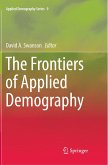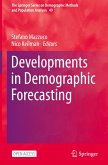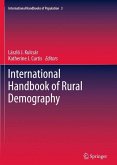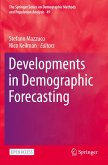Developments in Demography in the 21st Century
Herausgegeben:Singelmann, Joachim; Poston, Jr, Dudley L.
Developments in Demography in the 21st Century
Herausgegeben:Singelmann, Joachim; Poston, Jr, Dudley L.
- Gebundenes Buch
- Merkliste
- Auf die Merkliste
- Bewerten Bewerten
- Teilen
- Produkt teilen
- Produkterinnerung
- Produkterinnerung
This book introduces demographic applications which employ current demographic concepts and theories and cutting-edge methods and findings, all of which have and will continue to have an impact in the broad area of social demography. Through providing an introduction to new and current developments in demography, methodological and statistical issues, data issues, issues of health, aging and mortality, and issues in social demography, this book gives new insights into data, substantive issues, and methodological approaches that will assist readers in their use of demography in their research.…mehr
Andere Kunden interessierten sich auch für
![Developments in Demography in the 21st Century Developments in Demography in the 21st Century]() Developments in Demography in the 21st Century149,79 €
Developments in Demography in the 21st Century149,79 €![The Frontiers of Applied Demography The Frontiers of Applied Demography]() The Frontiers of Applied Demography113,99 €
The Frontiers of Applied Demography113,99 €![Developments in Demographic Forecasting Developments in Demographic Forecasting]() Developments in Demographic Forecasting41,99 €
Developments in Demographic Forecasting41,99 €![International Handbook of Rural Demography International Handbook of Rural Demography]() International Handbook of Rural Demography168,99 €
International Handbook of Rural Demography168,99 €![Developments in Demographic Forecasting Developments in Demographic Forecasting]() Developments in Demographic Forecasting33,99 €
Developments in Demographic Forecasting33,99 €![Social Demography Social Demography]() T. ChandraSekarayyaSocial Demography43,99 €
T. ChandraSekarayyaSocial Demography43,99 €![Studies in the Sociology of Population Studies in the Sociology of Population]() Studies in the Sociology of Population105,99 €
Studies in the Sociology of Population105,99 €-
-
-
This book introduces demographic applications which employ current demographic concepts and theories and cutting-edge methods and findings, all of which have and will continue to have an impact in the broad area of social demography. Through providing an introduction to new and current developments in demography, methodological and statistical issues, data issues, issues of health, aging and mortality, and issues in social demography, this book gives new insights into data, substantive issues, and methodological approaches that will assist readers in their use of demography in their research. At the same time it shows demographers, sociologists, economists, statisticians, methodologists, planners, and marketers how they may learn and improve upon the quality and relevance of their demographic investigations now and in the future.
Produktdetails
- Produktdetails
- The Springer Series on Demographic Methods and Population Analysis 48
- Verlag: Springer / Springer International Publishing / Springer, Berlin
- Artikelnr. des Verlages: 978-3-030-26491-8
- 1st edition 2020
- Seitenzahl: 348
- Erscheinungstermin: 25. Februar 2020
- Englisch
- Abmessung: 241mm x 160mm x 25mm
- Gewicht: 680g
- ISBN-13: 9783030264918
- ISBN-10: 3030264912
- Artikelnr.: 56999264
- Herstellerkennzeichnung
- Books on Demand GmbH
- In de Tarpen 42
- 22848 Norderstedt
- info@bod.de
- 040 53433511
- The Springer Series on Demographic Methods and Population Analysis 48
- Verlag: Springer / Springer International Publishing / Springer, Berlin
- Artikelnr. des Verlages: 978-3-030-26491-8
- 1st edition 2020
- Seitenzahl: 348
- Erscheinungstermin: 25. Februar 2020
- Englisch
- Abmessung: 241mm x 160mm x 25mm
- Gewicht: 680g
- ISBN-13: 9783030264918
- ISBN-10: 3030264912
- Artikelnr.: 56999264
- Herstellerkennzeichnung
- Books on Demand GmbH
- In de Tarpen 42
- 22848 Norderstedt
- info@bod.de
- 040 53433511
Joachim Singelmann is the Dean's Distinguished Professor of Public Policy in the Department of Demography at the University of Texas at San Antonio. His previous positions were at Louisiana State University, United Nations Population Division, University of California-San Diego, and Vanderbilt University. He obtained his M.A. and Ph.D. degrees at the University of Texas at Austin. Singelmann's research areas include industrial restructuring, transitions from central planning to market economies, demographic development, sociodemographic consequences of disasters, and inequality and poverty. His research has been funded by several foundations including NSF and the U.S. Departments of Labor, Health and Human Services, the Interior, and Agriculture. Singelmann is the author of many books and his research has been published in the major social science journals in the United States and Europe, including Demography, American Journal of Sociology, European Sociological Review, British Journal of Sociology, Social Forces, Rural Sociology, and Demographic Research. Singelmann has been the editor of Rural Sociology and President of the Southern Demographic Association and the Rural Sociological Society. Dudley L. Poston, Jr. is Professor of Sociology and the Abell Professor of Liberal Arts at Texas A&M University in College Station, Texas. Poston also holds the positions of Adjunct Professor of Demography at People's University, Beijing, China; Adjunct Professor of Sociology at Fuzhou University, Fuzhou, China; and Adjunct Professor of Demography at Nanjing Normal University, Nanjing, China. He previously served on the faculties of Cornell University (1988-1992) and the University of Texas at Austin (1970-1988). He has co-authored/edited eighteen books and over 320 journal articles, book chapters, and research reports. The 2nd edition of his demography text (with Leon Bouvier), Populationand Society: An Introduction to Demography was published in January, 2017. Poston is presently editing the 2nd edition of the Handbook of Population (Springer). At Texas A&M University he teaches graduate and undergraduate courses on Statistics, Demography, and Demographic Methods.
Part I. Introduction.- Chapter 1. "Developments in Demography" (Joachim Singelmann and Dudley L. Poston, Jr.).- Chapter 2. "What's Changing the World? A Demographer's Perspective" (Wendy Baldwin).- Part II. Methodological and Statistical Issues.- Chapter 3. "A Demographic Evaluation of the Stability of ACS Estimates for ACS Test Sites: 2000 to 2011" (J. Gregory Robinson and Eric B. Jensen).- Chapter 4. "Approaches for Addressing Missing Data in Statistical Analyses of Female and Male Adolescent Fertility" (Eugenia Conde and Dudley L. Poston, Jr.).- Chapter 5. "Considering Local Measures of Poverty Using Shift-Share Techniques: A Comparative Analysis" (Gregory L. Hamilton and Melody Muldrow).- Part III. Data Issues.- Chapter 6. "Potential Explanations for the high Net Undercount of Young Children in the U.S. Census" (William P. O'Hare).- Chapter 7. "Babies no Longer: Projecting the 100+ Population." (Howard Hogan and Sandra Colby).- Chapter 8. "Cohort approaches using educational data of the Czech Republic: Massification of Tertiary Education and its Impact on Education Attainment." (Vladimír Hulík, Klára Hulíková Tesárková).- Chapter 9. "The Socio-Demographic Consequences of the Deep-Water Horizon Oil Spill: Measurement Issues for Policy Mitigation" (Joachim Singelmann and Corey Sparks).- Part IV. Issues of Health, Aging, and Mortality.- Chapter 10. "Determinants of Female Sterilization in Brazil, 2001-2007" (Ernesto F. L. Amaral).- Chapter 11. "Potential reduction in mortality associated with the shifts of population educational structures in the Czech Republic" (Jitka Rychtaríková, Klára Hulíková Tesárková).- Chapter 12. "Aging and family support in the State of Mexico" (Viridiana Sosa Márquez).- Chapter 13. "Impact of population ageing on household structure: evidence from the Czech Republic" (Pavlína Habartová, Klára Hulíková Tesárková, Olga Sivková).- Chapter 14. "Intimate Homicide Mortality in Alaska from a Demographic Perspective" (Donna Shai).- Chapter 15. "Correlates of Cognitive Decline among the Elderly: The Case of Mexicans in Mexico and in the United States" (Silvia Mejia Arango, Joachim Singelmann, Rogelio Saenz).- Part V. Issues in Social Demography.- Chapter 16. "The Urban Hierarchies in China and the United States" (Qian Xiong and Dudley L. Poston, Jr.).- Chapter 17. "School District Formation as an Explanation for Spatial and Temporal Dimensions of Concentrated Poverty in Bexar County, Texas" (Matthew Martinez).- Chapter 18. "Marriage Selectivity & Stepfamily Formation (tentative title) (Gabriela Sánchez Soto).- Chapter 19. "Minority Student Participation in International Programs: A Survey of Undergraduate Students Attending HBCUs" (Komanduri S. Murty and Jimmy D. McCamey, Jr.).
Part I. Introduction.- Chapter 1. "Developments in Demography" (Joachim Singelmann and Dudley L. Poston, Jr.).- Chapter 2. "What's Changing the World? A Demographer's Perspective" (Wendy Baldwin).- Part II. Methodological and Statistical Issues.- Chapter 3. "A Demographic Evaluation of the Stability of ACS Estimates for ACS Test Sites: 2000 to 2011" (J. Gregory Robinson and Eric B. Jensen).- Chapter 4. "Approaches for Addressing Missing Data in Statistical Analyses of Female and Male Adolescent Fertility" (Eugenia Conde and Dudley L. Poston, Jr.).- Chapter 5. "Considering Local Measures of Poverty Using Shift-Share Techniques: A Comparative Analysis" (Gregory L. Hamilton and Melody Muldrow).- Part III. Data Issues.- Chapter 6. "Potential Explanations for the high Net Undercount of Young Children in the U.S. Census" (William P. O'Hare).- Chapter 7. "Babies no Longer: Projecting the 100+ Population." (Howard Hogan and Sandra Colby).- Chapter 8. "Cohort approaches using educational data of the Czech Republic: Massification of Tertiary Education and its Impact on Education Attainment." (Vladimír Hulík, Klára Hulíková Tesárková).- Chapter 9. "The Socio-Demographic Consequences of the Deep-Water Horizon Oil Spill: Measurement Issues for Policy Mitigation" (Joachim Singelmann and Corey Sparks).- Part IV. Issues of Health, Aging, and Mortality.- Chapter 10. "Determinants of Female Sterilization in Brazil, 2001-2007" (Ernesto F. L. Amaral).- Chapter 11. "Potential reduction in mortality associated with the shifts of population educational structures in the Czech Republic" (Jitka Rychtaríková, Klára Hulíková Tesárková).- Chapter 12. "Aging and family support in the State of Mexico" (Viridiana Sosa Márquez).- Chapter 13. "Impact of population ageing on household structure: evidence from the Czech Republic" (Pavlína Habartová, Klára Hulíková Tesárková, Olga Sivková).- Chapter 14. "Intimate Homicide Mortality in Alaska from a Demographic Perspective" (Donna Shai).- Chapter 15. "Correlates of Cognitive Decline among the Elderly: The Case of Mexicans in Mexico and in the United States" (Silvia Mejia Arango, Joachim Singelmann, Rogelio Saenz).- Part V. Issues in Social Demography.- Chapter 16. "The Urban Hierarchies in China and the United States" (Qian Xiong and Dudley L. Poston, Jr.).- Chapter 17. "School District Formation as an Explanation for Spatial and Temporal Dimensions of Concentrated Poverty in Bexar County, Texas" (Matthew Martinez).- Chapter 18. "Marriage Selectivity & Stepfamily Formation (tentative title) (Gabriela Sánchez Soto).- Chapter 19. "Minority Student Participation in International Programs: A Survey of Undergraduate Students Attending HBCUs" (Komanduri S. Murty and Jimmy D. McCamey, Jr.).

